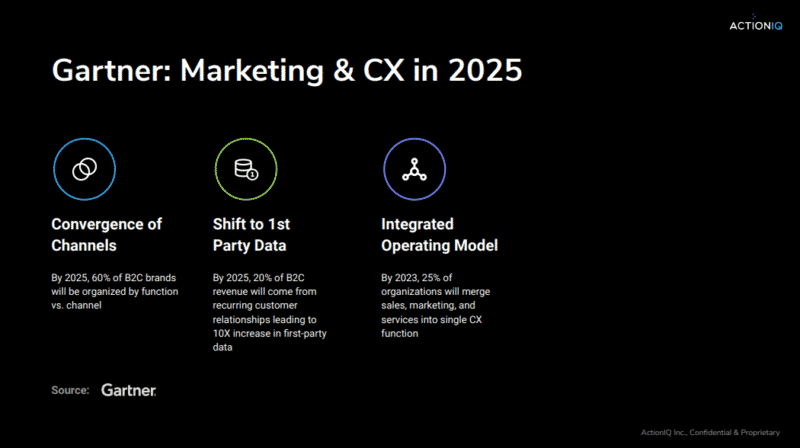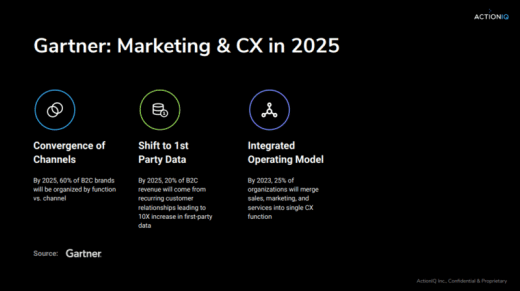Getting the most out of first-party data with a CDP
How Michael Kors met its data challenge and orchestrated more efficient campaigns.
Michael Kors has met the challenges of a looming cookie-less world and increased privacy regulations by implementing a data overhaul over the last four years. They centralized their first-party data in the ActionIQ CDP and have ramped up their strategy to include segmentation, orchestration and targeting lookalikes.
The success within the Michael Kors marketing team has caught on, according to Sharon Kratochvil, Vice President Global Analytics at Michael Kors. Now the playbook is being expanded to two other brands owned by parent company Capri Holdings Limited — Versace and Jimmy Choo.
First-party data is gold
“The consumer doesn’t care that marketing can have separate teams responsible for paid media or email marketing or CRM or stores,” said Tamara Gruzbarg, Head of Customer Insights at ActionIQ. “She just wants to be recognized by the brand as the consumer. She expects consistent messaging and a consistent brand experience across all of the touchpoints, irrespective of where she chooses to interact with the brand.”
Gruzbarg pointed to a Gartner study that predicts that by 2025, 60 percent of direct-to-consumer brands will be organized by function and not channel.

To adjust to this channel-agnostic experience, brands have to double down on their first-party customer data in order to cover all the bases.
“Gardner noticed this as a very important shift in the industry,” Gruzbarg said. “As brands are focusing on creating this holistic customer experience, they recognize the goldmine they have in the first-party data.”
But calling first-party data “gold” is just an exaggeration, right? Well, no. The same study also predicts that by 2025, 20 percent of direct-to-consumer revenue will come from recurring customer relationships, leading to a 10X increase in first-party data collection.
The anticipated interconnectedness of marketing, sales and services in the CX space would also call for an effective data strategy that allows customer data to be moved fluidly within the org.
CDP activation
“We explored a bunch of different options and we settled on a CDP as our key activation tool,” said Kratochvil.
They wanted a CDP that could hold all the data, and not just subsets, and be able to push it out to all marketing channels.
“This was really critical because that also allows us to automate and automation was a very key piece,” Kratochvil said. “The other thing that was very important to us is that the CDP could manage the volumes of data we intended to put in it. We were not just thinking of customer transactions. We were very new in this space, but we had strong ideas on where we wanted to go with our use of first party data.”
“You can’t really make assumptions in this day and age on what’s going to be important, right?” said Gruzbarg. “How many different data sources will you get in the future? What are going to be the predictive elements for consumer behavior in the next three, six or 12 months?”
“Our goal always was to leverage customer data to drive both business outcomes and marketing efficiencies, but I have to say we did start very small,” Kratochvil explained. “We now have a very powerful CDP. Our people and processes still had to catch up with the technology we had purchased.”
She added, “Our first campaigns focused on very basic, but high visibility, high impact campaigns, and leveraged only CRM data and purchase behavior data.”
Segmentation and personalization
More data didn’t necessarily mean more communications with customers. Instead, Michael Kors used their growing data arsenal to increase efficiencies, as well as impact.
“The CDP has enabled us to really seriously increase our segmentation and our personalization, both for marketing campaigns and journeys.” said Kratochvil . “And the really great news is that we have reduced our customer contacts while improving our marketing performance. So that’s exactly what you want to do.We’ve increased our marketing efficiency by reducing waste.”
The brand uses its CDP to generate suppression lists and also to conduct randomized controlled tests. This enables the marketing team to segment by channel.
“We have multiple channels,” Kratochvil explained. “We have outlet stores, we have lifestyle stores, we have e-commerce and collection stores, so really a very simple segmentation. But it’s very powerful so we tested things like the cadence, the content and what were those messages that resonated within each channel.”
She added, “Throughout this whole process we created controlled tests so that we could prove that channel segmentation did drive incremental revenue. That was always a key tenet — not just to do it, but to show that it worked, and build a confidence in the concept of segmentation and personalization.”
Acquisition strategy
Fine-tuning email cadence and efficiency provided a proof of concept that won buy-in from other departments. This meant the CDP functionality could expand to things like acquisition.
“We went to our digital marketing, particularly acquisition,” said Kratochvil. “Our acquisition is done by using lookalike models. So what we were able to do is identify who our very best customers were and then now start building lookalike models off of them with marketing partners.”
The success of using these lookalikes built up more confidence at Michael Kors.
She added, “We then started to adapt both our processes and our people…with some simple, straightforward tests as we grew. The goal was always to get our data to work for us. Now, any insight we generate in our work with the business can be activated on.”
This includes email data, site interactions, app interactions, loyalty programs and other first-party data sources.
“We’re building this very rich profile of our customers and then we’re leveraging that data for more segmentation and for personalization,” said Kratochvil.
Snapshot: Customer Data Platforms
Marketers today face increasing pressure to provide a unified experience to customers across many channels. And these avenues are growing each day. That’s why customer data platforms, or CDPs, have become more prevalent than ever. These help marketers identify key data points from customers across a variety of platforms, which can help craft cohesive experiences.
Cisco’s Annual Internet Report found that internet-connected devices are growing at a 10% compound annual growth rate (CAGR) from 2018 to 2023. COVID-19 has only sped up this marketing transformation. Technologies are evolving at a faster rate to connect with customers in an ever-changing world.
Each of these interactions has something important in common: they’re data-rich. Customers are telling brands a little bit about themselves at every touchpoint, which is invaluable data. What’s more, consumers expect companies to use this information to meet their needs.
Meeting customer expectations, breaking up these segments, and bringing them together can be demanding for marketers. That’s where CDPs come in. By extracting data from all customer touchpoints — web analytics, CRMs, call analytics, email marketing platforms, and more — brands can overcome the challenges posed by multiple data platforms and use the information to improve customer experiences. Learn more here.
The post Getting the most out of first-party data with a CDP appeared first on MarTech.
(26)



